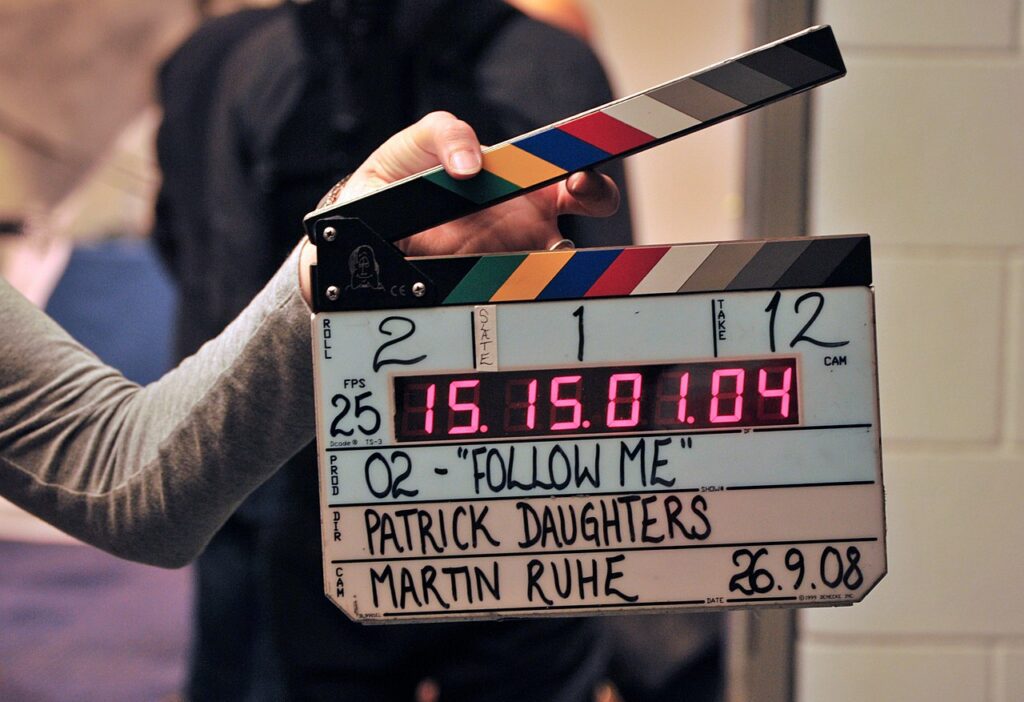You will notice the square-ish device used in between shots if you have seen behind-the-scenes clips of movies or shows. But did you know those boards were not just for aesthetics? They had a particular purpose.
The clapperboard is the square-hinged device used in movie sets to signal the start of filming with a “clap.” It is done in-frame so that it would be easier for editors to sync the audio and video.
What is the Clapperboard?
The clapperboard is a rectangular whiteboard with a hinged top piece that opens and closes. Through the years, it has been called several names:
- Sound marker
- Slate
- Sync slate
- Dumb slate
- Time slate
- Clapboard
- Clapperboard
- Cue board
- Film sticks
- Sound sticks
Before the clapperboard was invented, slate boards were used in silent films. Filmmakers used them to record and identify the type of film stock used for the shoot.
The clappy part was invented in the early 1920s by an Australian studio head named F.W. Thring. Soon, the sound was included in movies, and a sound engineer named Leon M. Leon combined Thring’s clapper with the slate board. The clapperboard was invented.
This device is used in filmmaking and video production to assist workers in synchronizing the video and the sound during post edit. This was very crucial since video and audio had to be perfectly synched. Imagine watching an actor speaking, and the sound was off by a few seconds. It will impact the entirety of the film.
The clapperboard is operated by the clapper loader or a camera assistant. The idea is to present clearly in view of the camera. The clapper loader will then strike the sticks to create the clapping sound once he gets clearance.
The clapperboard usually has the following pieces of information:
- Date
- Production title
- Name of the director
- Name of the director of photography (D.P.)
- Information on the scene
There is a slight variation to the information of the scene in American and European productions, but typically it includes the following:
- Scene number
- Camera angle
- Take number
Digislates have now replaced the standard chalkboards or dry-erase clapperboards, clapperboards loaded into a smart device. Nowadays, clapperboards are seldomly used, especially with films shot digitally. Digital films already have built-in functions such as filenames and other metadata. Editing is also usually done digitally, where video and audio files automatically sync. (Source: Premium Beat)
Clapper Loader Tasks and Responsibilities
The clapperboard is operated by a clapper loader or a camera assistant. Part of the responsibility of the loader is to ensure that the camera department runs as smoothly as possible. The clapper loader has to be very organized and has to have excellent attention to detail.
Work for the clapper loader, which is usually a camera assistant, starts before any filming begins. This person does the necessary preparations days before the actual shoot. He unpacks, tests, and prepares all the gear before the shoot.
During the shoot, the loader’s tasks include the following:
- Marking actors’ positions during rehearsals
- Record shot information in the camera report
- Coordinate work of camera crew members
- Handle lens finder when requested
- Keep inventory of camera equipment
- Keep track of consumables and order when necessary
- Maintain camera department paperwork
(Source: Lens Notes)
